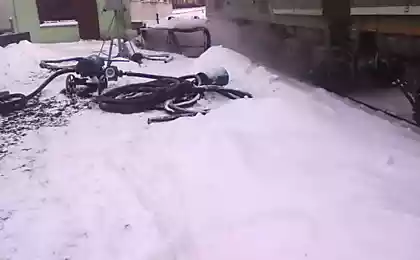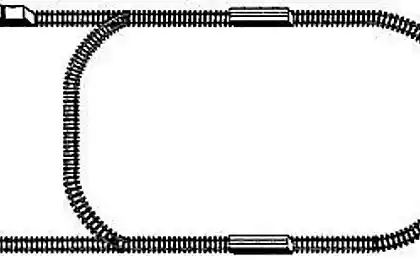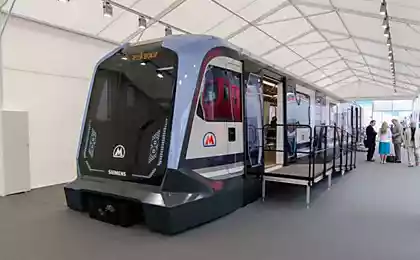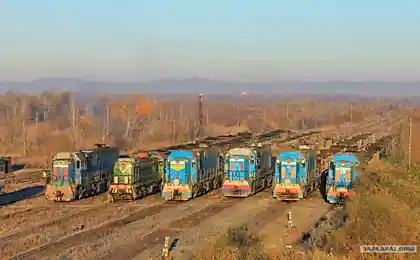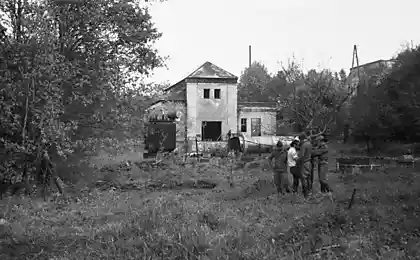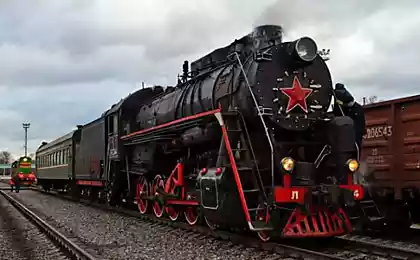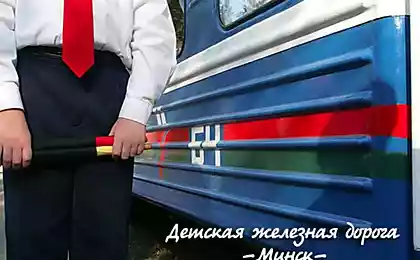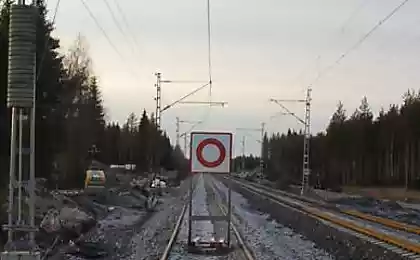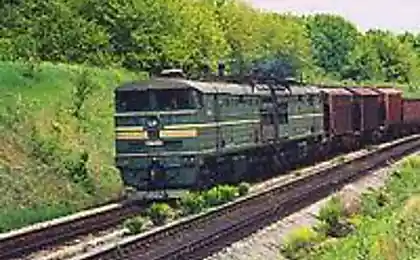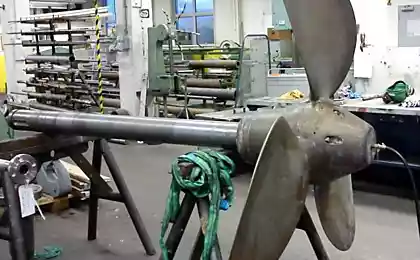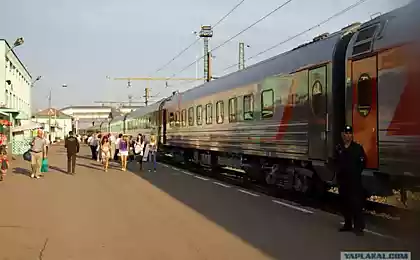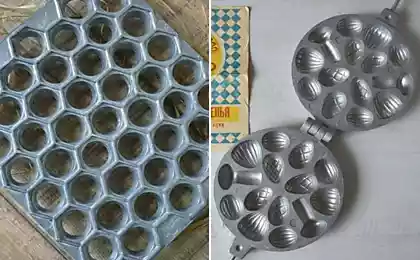2021
Locomotives
Introduced at the beginning of the XX century was the locomotive as a cost-effective replacement of low efficiency outdated locomotives and appeared at the same time electric locomotives, cost-effective only on highways with relatively large cargo and passenger traffic.
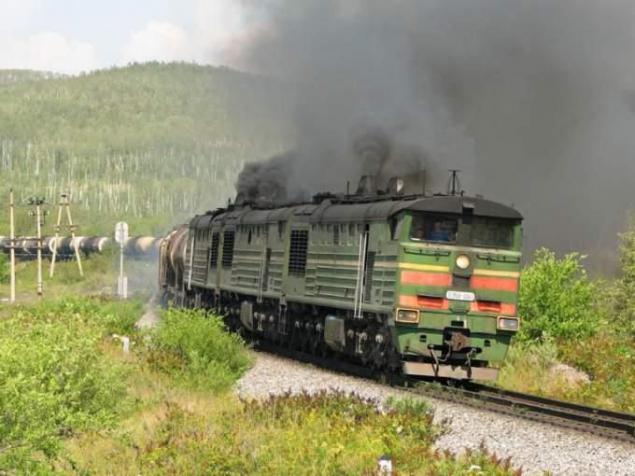
Passenger locomotives
TEP 60
Diesel TEP60 - passenger locomotives produced in the USSR at the Kolomna diesel locomotive factory from 1960 to 1985. It was built in 1241 this locomotive diesel modeli.Pervye TEP60 worked for some time on the Moscow - Leningrad, then locomotives of this series began serving passenger train Leningrad - Tallinn, Lozovaya - Melitopol.

TEP 60-1236
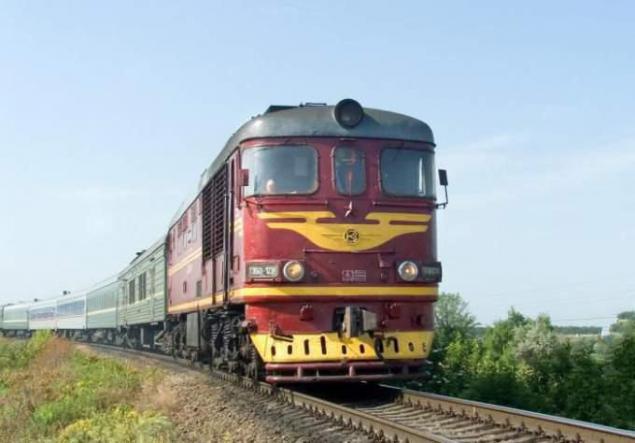
Built locomotive had welded the body supporting structure with two control room based on two Triaxial bogie. Power bodywork bearing the main types of loads consisted of two longitudinal pipes, which are located on the sides of box beams, pipes and connected with each other by four pivot beams. Bogie frame is made of forged and cast components connected by welding. Body Boarding - duralumin, and because of the impossibility of welding had to use the connection to the frame plating rivets. At the ends of the body placed shock-traction devices - coupler SA-3.
TEP 60-0451

The locomotive was installed 16-cylinder two-stroke diesel 11D45 series DN23 / 30 rated power of 3000 hp, designed for this locomotive Kolomna plant.
Part trolley locomotive TEP 60
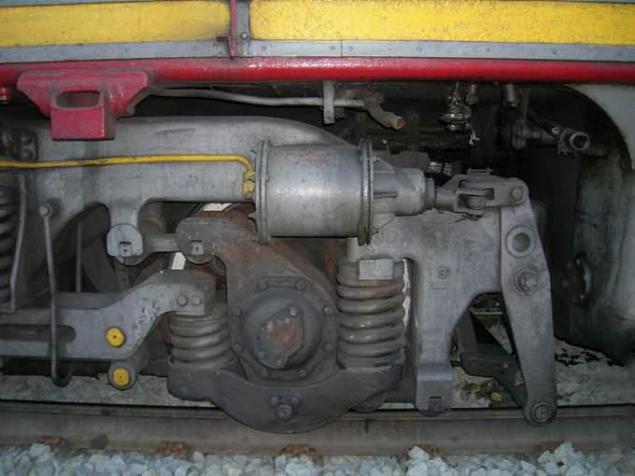
Remote driver TEP 60

TEP 70
The locomotive TEP 70 - passenger locomotives are produced in the Soviet Union and produced in a modified form in Russia at the Kolomna plant since 1973.
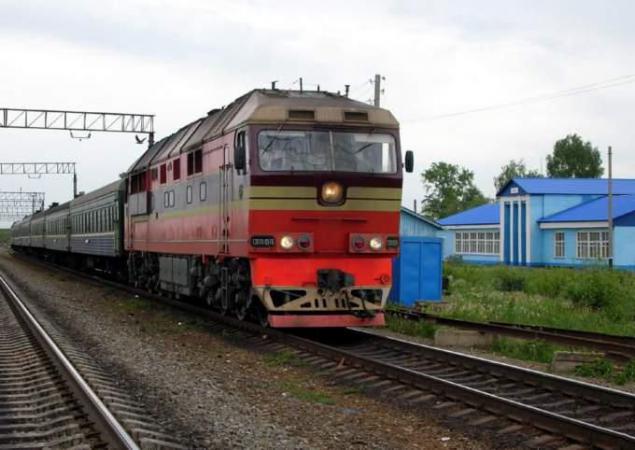
By design TEP70 partly similar to its predecessor TEP60 - also bearing body with similar contours, also three-axle truck with musculoskeletal RAMS drive systems Alstom (hollow shaft rigidly connected to the drive motor, the axis of the shaft inside the wheel pair, and the wheels are connected to the hollow shaft through rubber leashes), almost the same refrigeration unit with two fans having hydrostatic drive. However, there are many more differences. In particular, two-stroke diesel uneconomical series DN23 / 30 (the same as in locomotives M62, but with a larger number of cylinders and intercooled) is replaced by four-stroke 5D49 and dc transmission - the transmission of variable-DC. Power increased to 4000 hp instead of the previous 3000.
2 TPE 70
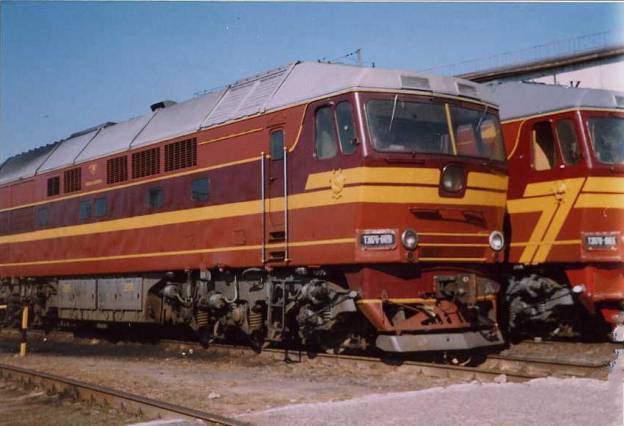
From 1973 to 2006 it produced 576 diesel locomotives TEP70, as explained by the release of small amounts of low power Kolomna plant. The first batch of locomotives were in custody in South road (Ukraine), including currants, Lyubotin, Poltava, Lozovaya, and the way to October. Then, the geography of TEP70 significantly expanded and they began to spread across Russia, replacing working in passenger traffic and freight locomotives displacing a TEP60, the main drawback of which was diesel fuel costs are very many.
TEP 70-0047
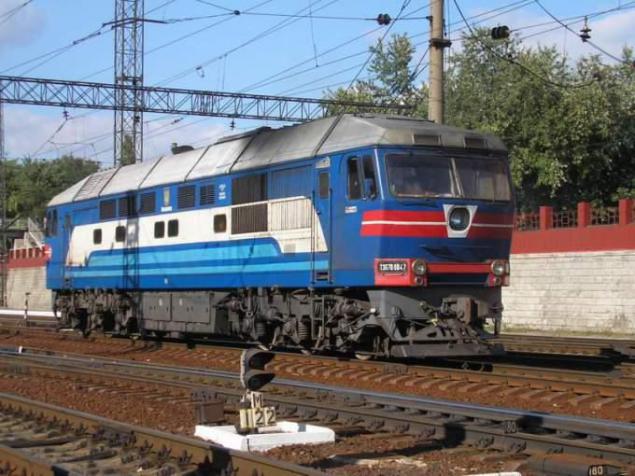
TEP 70-0498

Remote driver TEP 70
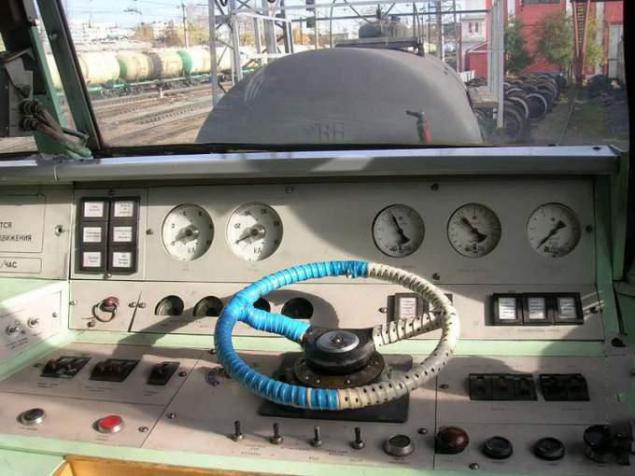
TEP 10
Diesel began to be issued in 1961 by the Kharkiv transport mashinostroeniya.Pervonachalno these locomotives were designated TE11 (under this series are released the first two locomotive) .Po test results locomotives TEP10 destination was driving heavy passenger trains.

TIC 10-048

Kharkov Plant built the locomotives in the period 1961-1968 gg. Locomotives of this series, in particular, came to the depot-Leningrad-Moscow passenger train to serve in the areas of Leningrad - Petrozavodsk, Leningrad - Cherepovets and depots Saratov, Volgograd and Tashkent.
This locomotive for a long time been the main locomotive in passenger traffic at the site Vekovka-Krasnoufimsk Gorky Railway. Including all passenger trains of art. Kazan went with this locomotive with a maximum speed of 110km / h and is called "arrow", despite the fact that the 80 th year, this line was completely electrified.
TIC 10-333
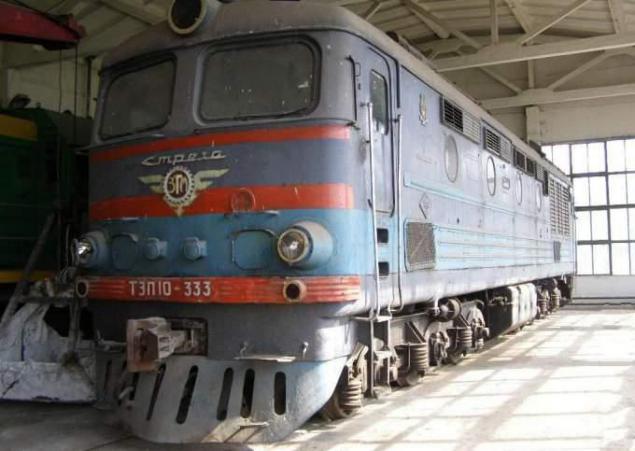
Technical data:
Design speed - 140 km / h. Power diesel - 3000 hp
TEP 150
TEP 150 (Ukr. TEP150) - six-axle mainline passenger locomotive with electric transmission, made on luhanskteplovoz (Ukraine) in 2007.

Specifications:
Power - 3100 kW (4216 hp)
Design speed - 160 km / h
Service weight - no more than 135 tonnes
Rated power delivered to the power supply train - 600 kW
Purpose - driving passenger trains in different climatic conditions
Transmission - electric, variable-DC, with traction control poosnogo
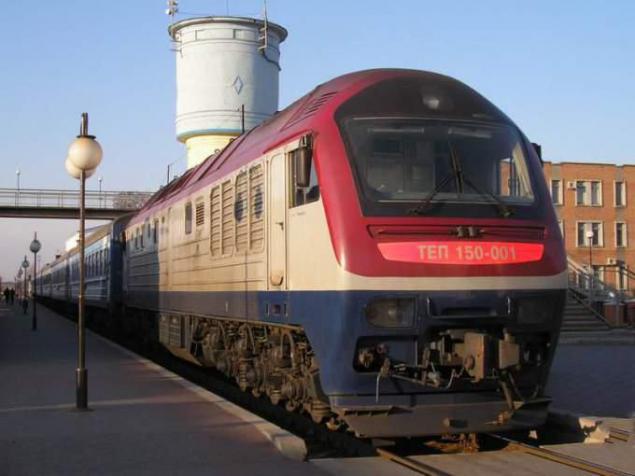
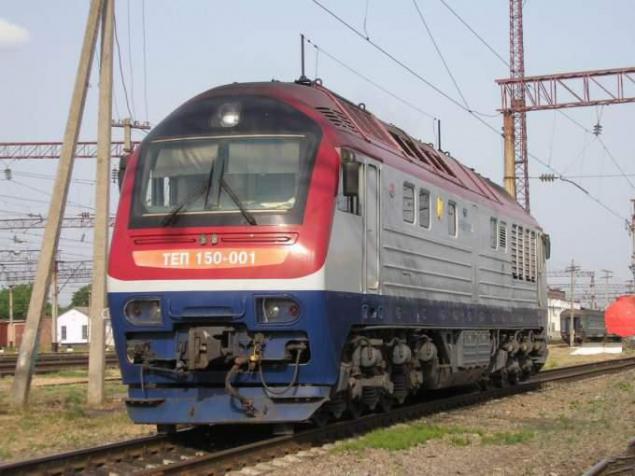

Freight locomotives
M 62
Diesel M 62 - Utility locomotive, created in 1965, is released on luhanskteplovoz 1965. Among railroad known as "Masha».
M 62-1376

His appearance locomotive M62 obliged one interesting fact: in 1961 Hungarian Railways bought the Swedish company «Nydqvist och Holm AB» (NOHAB) 20 diesel locomotives «Di3» capacity of 2000 liters. s., who were given the designation M61. The Soviet leadership (in particular, the first secretary of the CPSU Central Committee Nikita Khrushchev) was very displeased when they learned about the purchase. After this incident, the countries of the socialist camp was banned purchase of locomotives from capitalist countries. At the same time luhanskteplovoz has been sent the order: a matter of urgency to develop a locomotive in the envelope of the European railways for the 1435 mm, with a capacity of 2000 liter powerplant. p. The first test specimens were built in 1965. Since the new locomotive had roughly the same specifications with the already existing M61, the Hungarians gave him the designation M62. Later, this designation was used in the Soviet Union.
M 62-1336

Technical data:
Power diesel locomotive: 2000 hp
Design speed: 100 km / h
Diesel: 14D40 (renovated usually put diesel 2D49)
Weight: 116 tons
Axle load: 19, 3 tons
2M62-1251

3M62U-0099
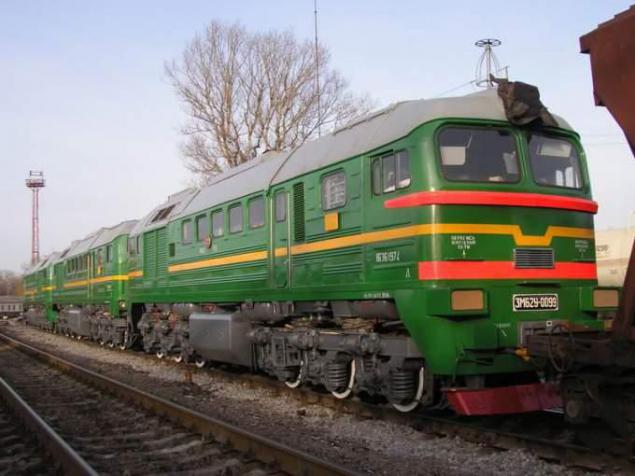
M 61 - "predecessor" M 62
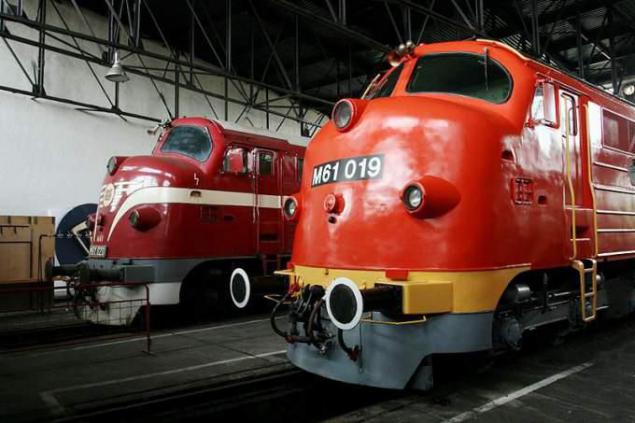
TE 10
TE10 Diesel - locomotive with electric transmission, type 10.
2TE 10-2110

2TE10M-0766
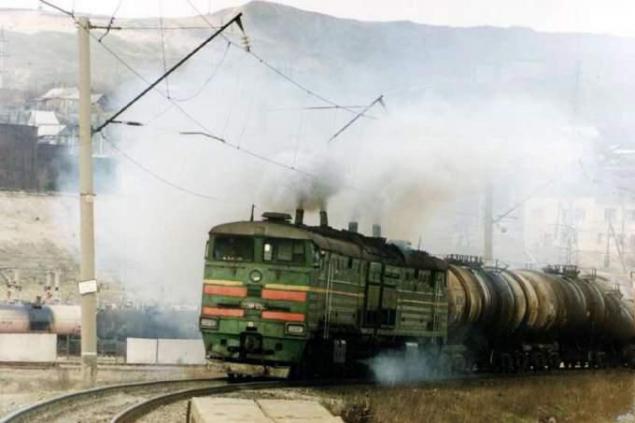
The first locomotive TE10 series has the following characteristics:
Service weight - 138 tons
Fuel capacity - 5500 kg
The stock oil - 1450 kg
Water capacity - 1500 kg
The stock of sand - 520 kg
The speed of continuous operation - 25 km / h
Design speed - 100 km / h
With significantly less weight compared with a two-locomotive TE3, TE10 diesel locomotives to successfully replace, single working draft.
Diesel-powered locomotive
TGC
Diesel THC - the serial Soviet shunting and industrial locomotive with hydraulic transmission, built at Kaluga machine factory.
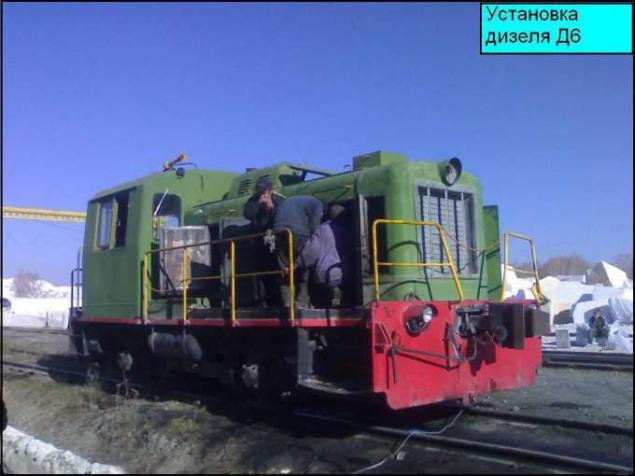
Is a precursor TGK2, replaced the rail car. It was built from 1958 to 1962 in the Kaluga machine factory. On Russian railways are not currently used.
TGC-5989
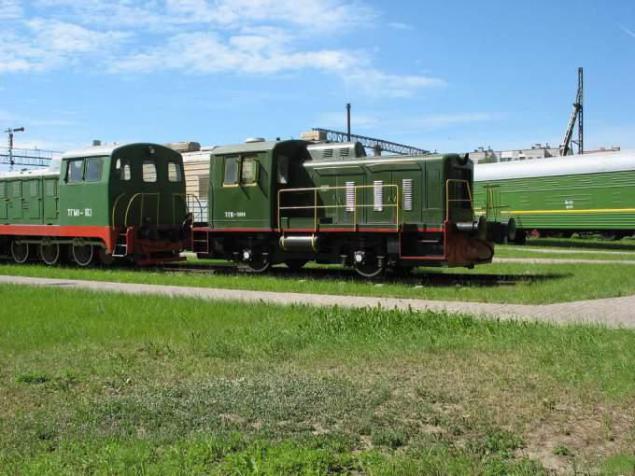
Features:
Years of construction - 1958-1962
Country of construction - the USSR
Plants built - Kaluga Engineering Plant
Total built - More than 684
Type - Hydraulic
The axial formula - 2
Power diesel engine - 150 hp
Design speed - 60 km / h [1]
The length (along the axes of automatic couplers) - 8270 mm
Width - 3150
Height - 3247
Fuel capacity - 600 kg
The stock of sand - 150 kg
TGM
The locomotive TGM - the first serial Soviet shunting locomotive with hydraulic transmission, is designed and built by the Murom.
TGM4-1036
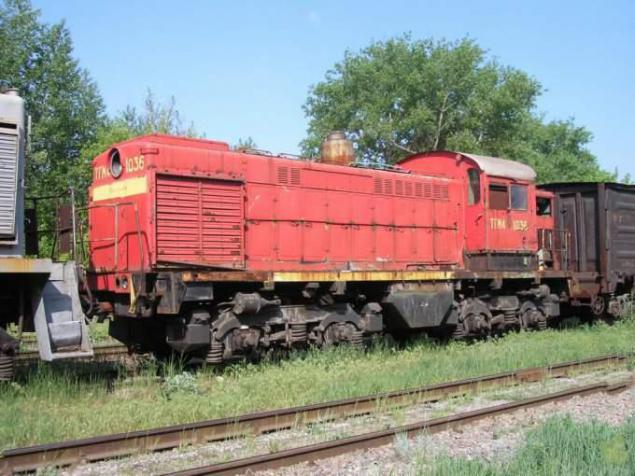
TGM6A-2435

Total from 1956 to 1972, the plant produced 3368 locomotive series TGM.
Most of the locomotives of this series were working in industrial enterprises, but part of the locomotives used for shunting operations at railway stations. Last TGM1 locomotive was removed from the park in 1990, the Ministry of Railways.
TGM40-0941
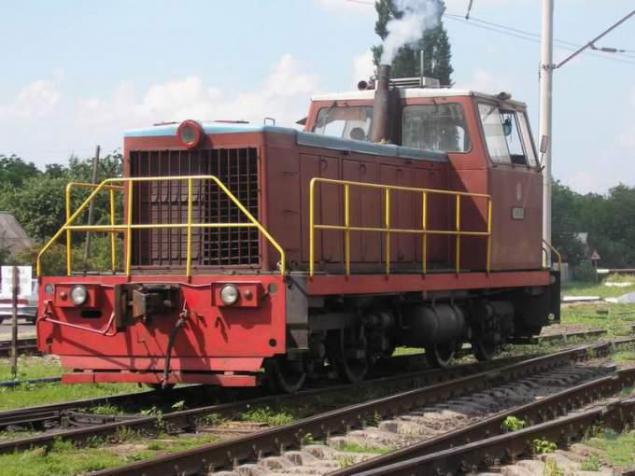
Specifications:
Maximum speed - 60 km / h
Maximum speed of train mode - 50 km / h
Maximum speed shunting mode - 30 km / h
Weight - 48 tons until 1965 and the release of 46 tons in future
TEM
The locomotive TEM - shunting locomotive with electric transmission.
TEM1-1660
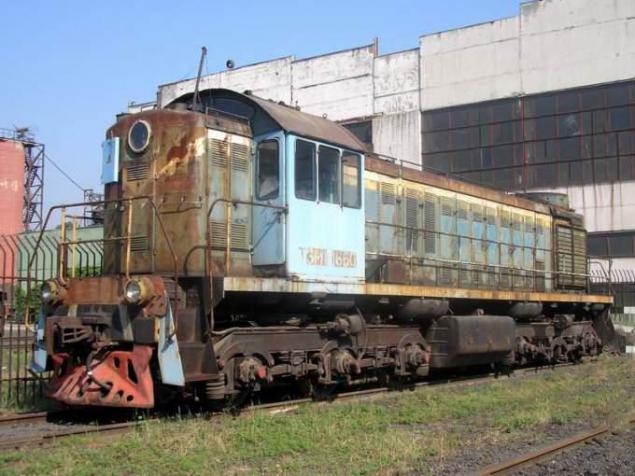
In 1973 Sinara Transport Machines drafted eight-odnokuzovnogo shunting locomotive with a diesel engine capacity of 2000 hp The locomotive is intended for export and shunting operations at the stations with the compositions, the weight of which requires locomotives pulling force by 40-50% higher than the six-axle shunting locomotives such as TEM1 and TEM2.
TEM2-5637
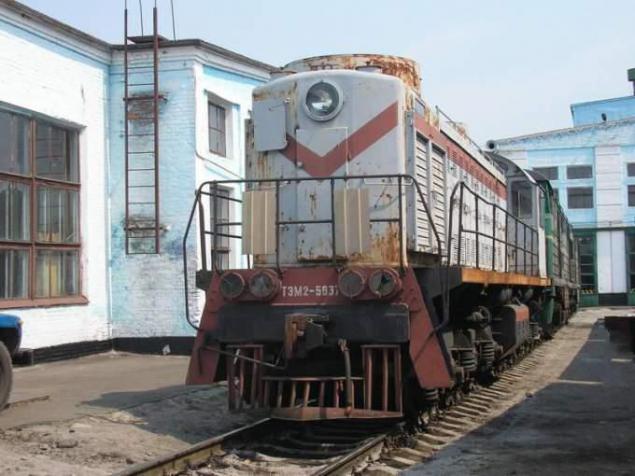
TEM2UM-394

Technical data:
Power diesel - 2000 hp
Design speed - 100 km / h.
Fuel capacity - 6000 kg
The stock oil - 800 kg
Fresh water - 950 kg
The volume of sand bunkers - 2300 kg.
Call of weight - 180 tons.
TEM7-0045
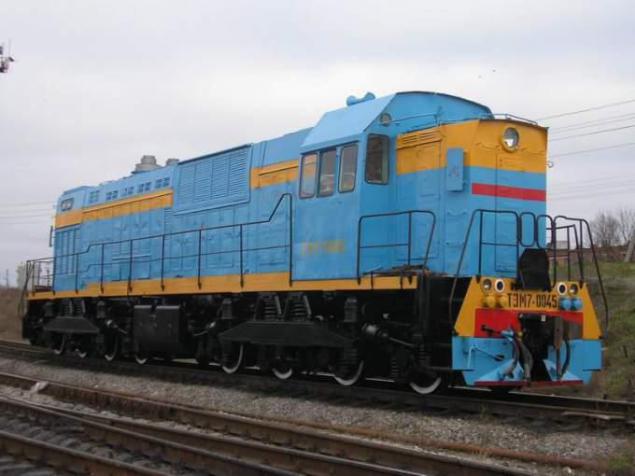
CHME3
Diesel CHME3 - a Czechoslovak shunting locomotive with electric transmission.
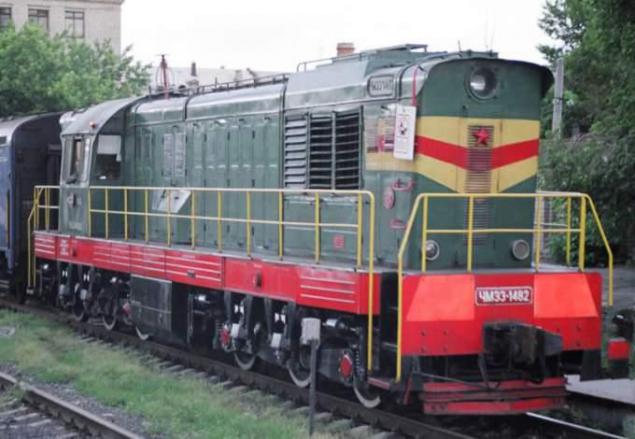
Insufficient capacity and drawbar weight CHME2 for shunting work with freight trains have led to the need for design and construction of the factories "CKD-Praga" more powerful locomotives. It was decided to build a railway to the Soviet Union, six-axle shunting locomotives with electric transmission. At the end of 1964 it built two experimental locomotives under the designation CHME3.
CHME3-826
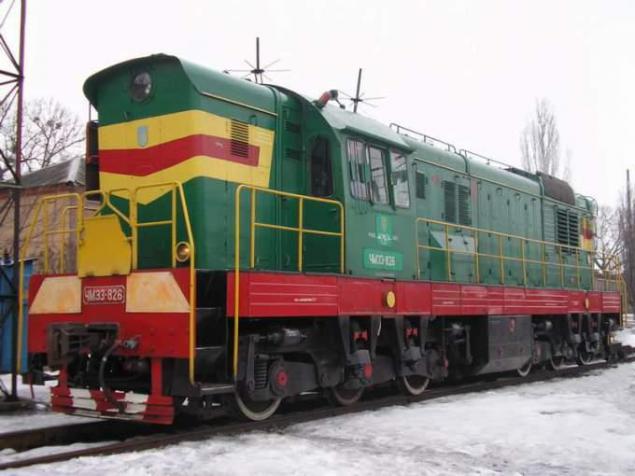
Remote driver CHMEZ
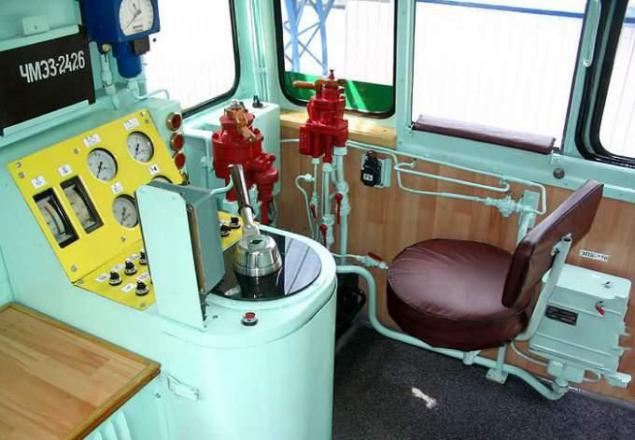
More locomotives:

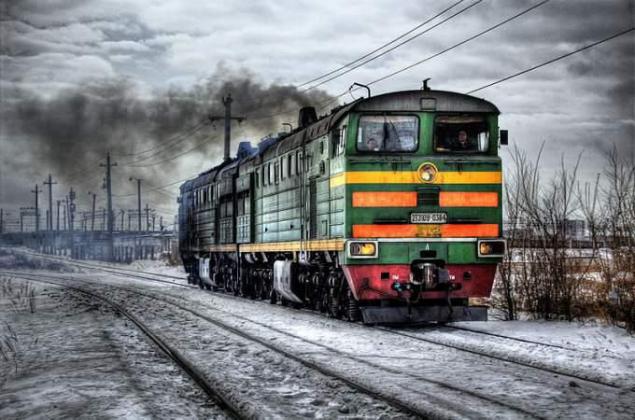

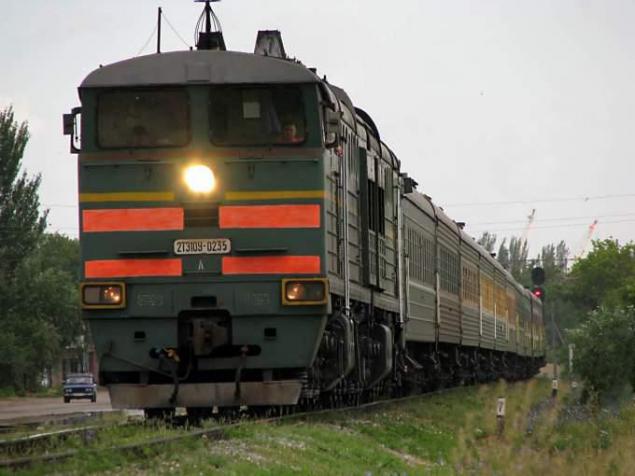
... And finally parozoz))) ...
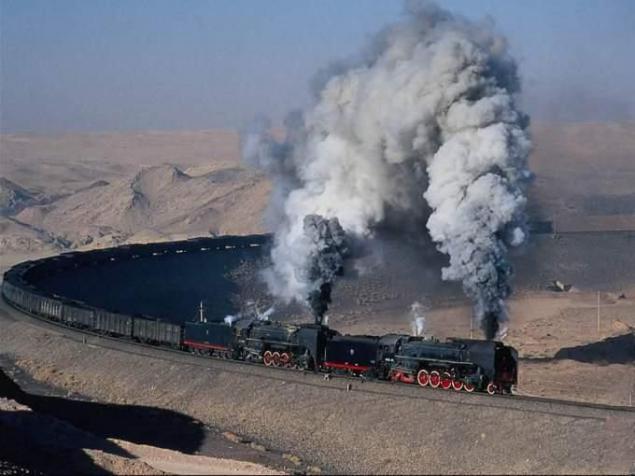
Nicknames locomotive
"Sneakers»
"Sarcophagus" because of the shape of the roof
"Humpback" because of the shape of the roof
"Brick" (more often given the nickname applied to electric locomotives EP1)
"Coffin" - the shape of the roof (this nickname is sometimes applied to electric locomotives and CHS2T CHS4T)
--img43--
Source: vasi.net

Passenger locomotives
TEP 60
Diesel TEP60 - passenger locomotives produced in the USSR at the Kolomna diesel locomotive factory from 1960 to 1985. It was built in 1241 this locomotive diesel modeli.Pervye TEP60 worked for some time on the Moscow - Leningrad, then locomotives of this series began serving passenger train Leningrad - Tallinn, Lozovaya - Melitopol.

TEP 60-1236

Built locomotive had welded the body supporting structure with two control room based on two Triaxial bogie. Power bodywork bearing the main types of loads consisted of two longitudinal pipes, which are located on the sides of box beams, pipes and connected with each other by four pivot beams. Bogie frame is made of forged and cast components connected by welding. Body Boarding - duralumin, and because of the impossibility of welding had to use the connection to the frame plating rivets. At the ends of the body placed shock-traction devices - coupler SA-3.
TEP 60-0451

The locomotive was installed 16-cylinder two-stroke diesel 11D45 series DN23 / 30 rated power of 3000 hp, designed for this locomotive Kolomna plant.
Part trolley locomotive TEP 60

Remote driver TEP 60

TEP 70
The locomotive TEP 70 - passenger locomotives are produced in the Soviet Union and produced in a modified form in Russia at the Kolomna plant since 1973.

By design TEP70 partly similar to its predecessor TEP60 - also bearing body with similar contours, also three-axle truck with musculoskeletal RAMS drive systems Alstom (hollow shaft rigidly connected to the drive motor, the axis of the shaft inside the wheel pair, and the wheels are connected to the hollow shaft through rubber leashes), almost the same refrigeration unit with two fans having hydrostatic drive. However, there are many more differences. In particular, two-stroke diesel uneconomical series DN23 / 30 (the same as in locomotives M62, but with a larger number of cylinders and intercooled) is replaced by four-stroke 5D49 and dc transmission - the transmission of variable-DC. Power increased to 4000 hp instead of the previous 3000.
2 TPE 70

From 1973 to 2006 it produced 576 diesel locomotives TEP70, as explained by the release of small amounts of low power Kolomna plant. The first batch of locomotives were in custody in South road (Ukraine), including currants, Lyubotin, Poltava, Lozovaya, and the way to October. Then, the geography of TEP70 significantly expanded and they began to spread across Russia, replacing working in passenger traffic and freight locomotives displacing a TEP60, the main drawback of which was diesel fuel costs are very many.
TEP 70-0047

TEP 70-0498

Remote driver TEP 70

TEP 10
Diesel began to be issued in 1961 by the Kharkiv transport mashinostroeniya.Pervonachalno these locomotives were designated TE11 (under this series are released the first two locomotive) .Po test results locomotives TEP10 destination was driving heavy passenger trains.

TIC 10-048

Kharkov Plant built the locomotives in the period 1961-1968 gg. Locomotives of this series, in particular, came to the depot-Leningrad-Moscow passenger train to serve in the areas of Leningrad - Petrozavodsk, Leningrad - Cherepovets and depots Saratov, Volgograd and Tashkent.
This locomotive for a long time been the main locomotive in passenger traffic at the site Vekovka-Krasnoufimsk Gorky Railway. Including all passenger trains of art. Kazan went with this locomotive with a maximum speed of 110km / h and is called "arrow", despite the fact that the 80 th year, this line was completely electrified.
TIC 10-333

Technical data:
Design speed - 140 km / h. Power diesel - 3000 hp
TEP 150
TEP 150 (Ukr. TEP150) - six-axle mainline passenger locomotive with electric transmission, made on luhanskteplovoz (Ukraine) in 2007.

Specifications:
Power - 3100 kW (4216 hp)
Design speed - 160 km / h
Service weight - no more than 135 tonnes
Rated power delivered to the power supply train - 600 kW
Purpose - driving passenger trains in different climatic conditions
Transmission - electric, variable-DC, with traction control poosnogo



Freight locomotives
M 62
Diesel M 62 - Utility locomotive, created in 1965, is released on luhanskteplovoz 1965. Among railroad known as "Masha».
M 62-1376

His appearance locomotive M62 obliged one interesting fact: in 1961 Hungarian Railways bought the Swedish company «Nydqvist och Holm AB» (NOHAB) 20 diesel locomotives «Di3» capacity of 2000 liters. s., who were given the designation M61. The Soviet leadership (in particular, the first secretary of the CPSU Central Committee Nikita Khrushchev) was very displeased when they learned about the purchase. After this incident, the countries of the socialist camp was banned purchase of locomotives from capitalist countries. At the same time luhanskteplovoz has been sent the order: a matter of urgency to develop a locomotive in the envelope of the European railways for the 1435 mm, with a capacity of 2000 liter powerplant. p. The first test specimens were built in 1965. Since the new locomotive had roughly the same specifications with the already existing M61, the Hungarians gave him the designation M62. Later, this designation was used in the Soviet Union.
M 62-1336

Technical data:
Power diesel locomotive: 2000 hp
Design speed: 100 km / h
Diesel: 14D40 (renovated usually put diesel 2D49)
Weight: 116 tons
Axle load: 19, 3 tons
2M62-1251

3M62U-0099

M 61 - "predecessor" M 62

TE 10
TE10 Diesel - locomotive with electric transmission, type 10.
2TE 10-2110

2TE10M-0766

The first locomotive TE10 series has the following characteristics:
Service weight - 138 tons
Fuel capacity - 5500 kg
The stock oil - 1450 kg
Water capacity - 1500 kg
The stock of sand - 520 kg
The speed of continuous operation - 25 km / h
Design speed - 100 km / h
With significantly less weight compared with a two-locomotive TE3, TE10 diesel locomotives to successfully replace, single working draft.
Diesel-powered locomotive
TGC
Diesel THC - the serial Soviet shunting and industrial locomotive with hydraulic transmission, built at Kaluga machine factory.

Is a precursor TGK2, replaced the rail car. It was built from 1958 to 1962 in the Kaluga machine factory. On Russian railways are not currently used.
TGC-5989

Features:
Years of construction - 1958-1962
Country of construction - the USSR
Plants built - Kaluga Engineering Plant
Total built - More than 684
Type - Hydraulic
The axial formula - 2
Power diesel engine - 150 hp
Design speed - 60 km / h [1]
The length (along the axes of automatic couplers) - 8270 mm
Width - 3150
Height - 3247
Fuel capacity - 600 kg
The stock of sand - 150 kg
TGM
The locomotive TGM - the first serial Soviet shunting locomotive with hydraulic transmission, is designed and built by the Murom.
TGM4-1036

TGM6A-2435

Total from 1956 to 1972, the plant produced 3368 locomotive series TGM.
Most of the locomotives of this series were working in industrial enterprises, but part of the locomotives used for shunting operations at railway stations. Last TGM1 locomotive was removed from the park in 1990, the Ministry of Railways.
TGM40-0941

Specifications:
Maximum speed - 60 km / h
Maximum speed of train mode - 50 km / h
Maximum speed shunting mode - 30 km / h
Weight - 48 tons until 1965 and the release of 46 tons in future
TEM
The locomotive TEM - shunting locomotive with electric transmission.
TEM1-1660

In 1973 Sinara Transport Machines drafted eight-odnokuzovnogo shunting locomotive with a diesel engine capacity of 2000 hp The locomotive is intended for export and shunting operations at the stations with the compositions, the weight of which requires locomotives pulling force by 40-50% higher than the six-axle shunting locomotives such as TEM1 and TEM2.
TEM2-5637

TEM2UM-394

Technical data:
Power diesel - 2000 hp
Design speed - 100 km / h.
Fuel capacity - 6000 kg
The stock oil - 800 kg
Fresh water - 950 kg
The volume of sand bunkers - 2300 kg.
Call of weight - 180 tons.
TEM7-0045

CHME3
Diesel CHME3 - a Czechoslovak shunting locomotive with electric transmission.

Insufficient capacity and drawbar weight CHME2 for shunting work with freight trains have led to the need for design and construction of the factories "CKD-Praga" more powerful locomotives. It was decided to build a railway to the Soviet Union, six-axle shunting locomotives with electric transmission. At the end of 1964 it built two experimental locomotives under the designation CHME3.
CHME3-826

Remote driver CHMEZ

More locomotives:




... And finally parozoz))) ...

Nicknames locomotive
"Sneakers»
"Sarcophagus" because of the shape of the roof
"Humpback" because of the shape of the roof
"Brick" (more often given the nickname applied to electric locomotives EP1)
"Coffin" - the shape of the roof (this nickname is sometimes applied to electric locomotives and CHS2T CHS4T)
--img43--
Source: vasi.net


